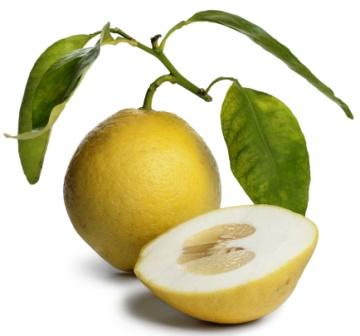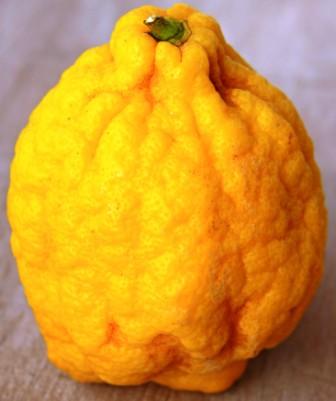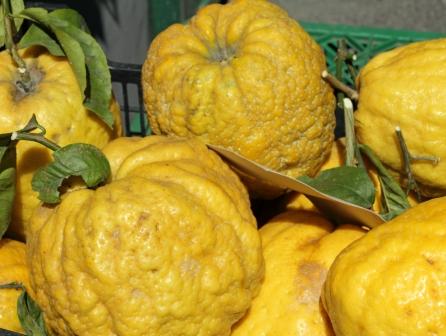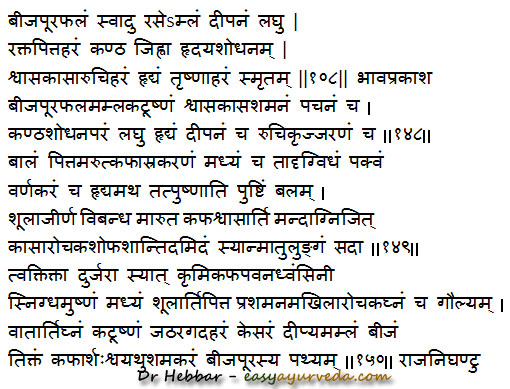Citron Fruit: Citrus medica Uses, Dose, Research, Side Effects
Citron fruit looks like a big lemon, with very thick skin with very less inner pulp content. Its fruit peel, seed, pulp etc are used in Ayurvedic treatment. It is widely used for treating abdominal colic, digestive disorders, piles etc.

Table of Contents
Unripe fruit uses
Unripe fruit (Baala phala) or Semi ripe (Madhya) citron fruit –
Increases / vitiates Pitta, Vata, Kapha and Rakta
The filaments of Matulunga – Citron fruit – Citrus Citrus lemon are useful in colic pain, anorexia, constipation, impairment of digestion, alcoholism, hiccough, dyspnoea, cough, vomiting, disorders relating to faces and such other diseases as arise from the vitiated Vata as well as Kapha. Charaka Sutrasthana 27/154
Juice is used to relieve the pain of bee stings, used in treating scurvy.
The skin or epicarp [tvak] of the citrus medica being pungent in taste and oily in composition appeases the kapha and vAta doShAs and controls the growth of intestinal parasites.
The mesocarp [mAMsa] of the citrus medica is too is oily in nature and nourishes the tissues; increases virility and pacifies the vAta and pitta doShAs.
The flowers [kshara] of the Citrus medica increases the digestive agni and is beneficial in patients of dyspnoea, cough, vomiting, thirst and parched throat caused by the kapha and vAta doShAs.The flowers provides benefits to the patients of gulma and abdominal colic too.
In rainy seasons [ghnAgame] the Matulunga should be taken with the saindhava lavana; in sharad season it is adviceable to be taken along with sita [sugar candy].
In the season of hemanta, the Matulunga is advisable to be taken along with salt, ginger, asafetida and black peppers mixed together. Same to be followed in the seasons of shishira and magha.
The jaggery needs to be mixed with Matulunga fruit for consumption during the Grishma season.

Madiphala or Matulunga appears like a big lemon but is elongated and has a rough surface. The skin will be thick and the inner pulp will be thin and less.
In Ayurveda it is considered as widely used in the treatment of Pitta disorders and as a good cardiac tonic. It is used in several Gastrointestinal disorders like gastric ulcers, abdominal colic, digestive disturbance, piles, mal-absorption, IBS etc.
The fruit is rich in vitamin C and hence it boosts the immune system. It plays a key role in formation of collagen, thereby improving skin elasticity and reducing wrinkles. Hence it helps in maintaining the health and luster of the skin.
The fruits are rich in calcium, phosphorus, iron and carotene contents and hence helpful to restore the health of the bone, blood and muscle tissues. Also it will safeguard the organs like kidney, liver and heart.

Botanical name- Citrus medica Linn.
Family- Rutaceae (Jambira kula)
Vernacular names
Names in different languages:
Hindi name- Bijoura, bara neebu, purak, turanj, vetas
English name- Citron, wild lemon
Bengali name- Begpur
Kannada name – maadala, deva maadala, maadavaala, maathulanga, mahaaphala.
Telugu name- Madiphalam, Nimmakaya, matulungamu, Dabbakaya
Tamil name- Kadara- Narathai, elumiccai, kommatti-matulai, turunji, turunchi, koti naratthai, kommatti maatulai
Malayalam name – Ganapathi Narakam, cerunaarakam
Konkani name – mauling
Assamese name – Namutenga / kaji tenga, Jora tenga
Bengali name – jambeera, taba
Gujarati name – turanj
Manipuri name – heijang
Marathi name – mahalunga
Urdu name – ab-e-turanj, poast turanj.
Persian name – kalimbak
Arab name – qalambak
Madiphal Home Remedies
In muscle wasting
By Dr MS Krishnamurthy MD (Ayu), PhD.
1. Madiphal Fruit pulp in muscle wasting and emaciation:
Mature fruits are taken, skin is removed. Plain white colored pulp is taken (8-10 pieces/50-60 gram) regularly. This improves the absorption and helps to gain weight among the people who are lean. Also, this is very effective for the patients with muscle wasting due to paralysis, muscular dystrophy.
During pregnancy, puerperum
2. Citrus medica Leaf soup for pregnancy and puerperal period:
Mature leaves are washed thoroughly. The leaves are cooked with water and added a little salt and turmeric powder. This soup is used in traditional practices of South Kanara district, during pregnancy and puerperal period. Good benefits are claimed to get rid of nausea, vomiting and fatigue developed during pregnancy and to avoid the swelling in the legs during the puerperal period.
In acid peptic disorders
3. Fresh fruit juice or jelly or syrup in acid peptic disorders:
Citron fruit is very effective in acid peptic disorders. So, the fruit pulp can be used in various forms like fresh juice, syrup or jelly to pacify gastric irritation.
In scorpion bite
4.Tender leaf paste over the scorpion bite:
A fist full of tender leaves are taken and fine paste is made. This is applied over the site of scorpion bite. This pacifies burning and pain caused in the area instantly.
For headache
10-15 mature leaves are taken and fine paste is made. This is cooked with 100 ml of coconut oil or sesame oil till the oil is free from moisture content.This oil is used to apply over the scalp to reduce the headache.
Citron is a medicinal fruit that can enrich the health of the skin and gastrointestinal tract. As the fruit is less exposed, once after popularization this fruit has every chance to get a lead in the world of sour fruits!
Medicinal properties
Citron fruit medicinal properties:
Rasa (taste) – Amla (sour), Madhura – sweet
Guna- Laghu, Snigdha,
Vipaka- Amla – Undergoes sour taste conversion after digestion
Veerya – Ushna – Hot potency
Effect on Tridosha – Balances Vata and Kapha Dosha
Pharmacological action – Stimulant, CArminative, digestive, cardiac stimulant, Hemostatic
Roots are laxative, diuretic, Anthelmintic
Qualities as per Bhojana Kutuhalam
According to Bhojana kutuhalam, The tender and partially matured fruit of matulunga excessively vitiates all the three doshas, The fully matured fruit imparts good complexion, acts as a cardio tonic, strengthens and nourishes the body. Matulunga fruit helps in treating colicky pain, indigestion, hard bowels, disorders caused due to vitiated vata and kapha, dyspnoea, improves taste perception, appetizing, cures tastelessness, edema and also mitigates kapha dosha.
Part used, dosage
Part used- Fruit, root
Dosage- Fruit juice 10-20 ml
Decoction – 50 -80 ml
Citron fruits are used in preparing a special drink called Shadava. (Kaiyadeva Nighantu)
They are also used for preparing pickles in South India.
Sanskrit verse

Citron uses
Ripe fruit –
Deepana – improves digestion strength
Laghu – light to digest
Kanta Shodhana – Cleanses throat
Hrudaya Shodhana – Cleanses and detoxifies heart
Jihva Shodhana – Cleanses and detoxifies tongue
Hrudya – acts as cardiac tonic, congenial for heart
Jarana – improves digestion strength
Varnakara – Improves skin tone and complexion
Pushtikara – nutritious, improves nourishment
Balakara – improves strength and immunity
Indications
Indicated in –
Raktapitta –Bleeding disorders such as nasal bleeding, heavy periods, etc
Shwasa – asthma and chronic respiratory disorders
Kasa – cough, cold
Aruchi – anorexia
Trushna – excessive thirst
Shoola – abdominal colic pain
Ajeerna – indigestion
Vibandha – Constipation
Kaphashwasa – cough with sputum
Mandagni – low digestion strength
Arochaka – anorexia
Shopha – inflammation
Shoola – abdominal colic pain
Arti – pain
Skin uses
Skin / peel of the ripe citron fruit –
Tikta – bitter
Durjara – Hard to digest
Indicated in –
Krumi – worm infestation
Balances Vata and Kapha Dosha
Stamen uses
Stamen – Keshara
Vatartighna – Indicated in pain and abdominal colic due to Vata / bloating
Katu – Pungent
Ushna – Hot
Jathara Gadahara – indicated in abdominal disorders
Seed uses
Beeja – Seed
Deepya – improves digestion
Amla – Sour
Tikta – bitter
Indicated in –
Kaphaja arsha – Piles with big mass and itching
Shotha – Swelling, inflammation
Research
In Vitro study on diabetes, Alzheimer’s disease
Ayurvedic medicines
Ayurvedic medicines with Citron as ingredient:
Madiphala Rasayana – For gastritis, vomiting, indigestion
Dhatri Rasayan – used for rejuvenation and to improve strength and immunity.
Narasimha Rasayana – for the treatment of weakness, weight gain, hair growth and rejuvenation.
Dasamoola Rasayanam – for many acute and chronic respiratory diseases.
Kshara Thailam – an herbal oil, used in the treatment of tinnitus, ear ache, hearing loss, worm infestation etc.
Matulungadi kwatha
Side effects
Unripe fruits are unhealthy for consumption.
Very sour fruits are contraindicated in High Pitta conditions such as bleeding disorders (heavy periods), nasal bleeding, burning sensation, gastritis etc.
Like all the It should not be consumed along with milk.
How to consume? Similar to lemon
Interaction with medicines, supplements
Can this be used while taking Homeopathic medicine?
Yes. This product does not react with homeopathic medicine.
Can this medicine be continued while taking supplements like multivitamin tablets, Omega 3 fatty acids etc?
Yes. Generally, this product goes well with most dietary supplements. However, if you are taking more than one product per day, please consult your doctor for an opinion.
With western
medicines
Seek your
doctor’s advice if you are taking this product along with other western
(allopathic / modern) medicines. Some Ayurvedic herbs can interact with modern
medicine.
If both Ayurvedic and allopathic medicines are advised together, then it is
best to take Allopathic medicine first, wait for 30 minutes and then take the
Ayurvedic medicine.
Other uses
Usage in sweating treatment:
Its fruits and leaves are used for inducing sweating, as part of a treatment, called Jambeera Pindasweda, Naranga Kizhi
Citron fruit juice is used in preparing paste (kalka) for the purpose of ghrita murchana – a special processing method of ghee.
Sanskrit Synonyms
Matulunga – Useful in conditions like anorexia
Madiphalam
Beejahva, Beejapoorna
Phalapooraka – Fruit contain plenty of seeds
Kesara, Kesaramla – Saffron, orangish color
Jantughna – Useful in intestinal worm infestation
Danturastvacha – Having thick fruit skin
Ruchaka, Rochanaphala – Fruit improves appetite, useful in anorexia
Chemical composition
Citrus medica chemical composition:
Citric acid, Sulphuric acid, glucose, Abscisic Acid, Abscisin II, Limonin, Limonene, Limocitrol, Rutin etc.
Peel contains citrol, citrine.
Classical categorization
Charaka –
Hrudya – group of herbs that act as cardiac tonic, congenial for heart
Chardinigrahana – group of herbs useful in vomiting
Susruta- Phala varga – Group of fruits
Vagbhata- Phala varga
Bhavaprakasha – Amradi Phalavarga, Panchamla (five sour fruits – Amlavetasa, Vrukshamla, Brihat Jambeera, Nimbuka, Beejapoora)
Kaiyadeva Nighantu – Pancha Pallava – group of five fresh leaf sprouts (Amra, Jambu, Kapittha, Beejapura, Bilva)
Raja Nighantu, Dhanvantari nighantu – Amradi Varga
Taxonomy
Kingdom – Plantae
Class – Dicotyledons
Order – Geraniales
Family – Rutaceae
Genus – Citrus
Species – medica
Morphology
Evergreen shrub with thorny branches. Bark is yellowish brown in color
Leaves – Oblong or elliptic. coriaceous, glabrous,
Inflorescence – Axillary cymes
Flower – White, tinged with pink.
Fruit – Large berries, Fleshy, yellow when ripe
Seeds – Few in number, smooth
Part used – Fruit, Root
Sthanika Karma (Systemic Action)
External Application – Its bark exhibits analgesic properties, while hot leaves can be applied to painful areas for pain relief. Additionally, the seeds have a scraping action that helps reduce edema and possess anti-poisonous properties.
Internal administration-
Nervous system – Help to reduce the toxic effect of drugs / Alcohol.
Digestive System – Carminative, relieve excess thirst, facilitate movement of doshas in proper direction, Liver stimulant, Anthelmintic. Indicated in Anorexia, Loss of appetite, Excessive thirst, Vomiting, Abdominal colic pain, Hemorrhoids etc. root bark decoction is indicated in worm infestation.
Circulatory System – Sweet fruit has Hridya property (good for heart) and is indicated in bleeding disorders. Sour fruit is heart stimulant. Its flower and root are also beneficial in bleeding disorders.
Respiratory system – Indicated in cough, breathing disorders and in Hiccough
Reproductive system –Fruit and Seeds are uterine stimulants. beneficial in dysmenorrhea.











19 comments
sumathi r.
Very useful article about a common, household fruit. We in tamilnadu use this a lot as pickle, both salted and with chilli. Elders at home used to encourage us to have this with buttermilk rice, saying that it would aid digestion. Is it also good for pittam?? Thanks
Jean-Pierre
excellent! Congratulation!
V.Sridhar murthy
Excellent article. Very informative.
Lakkannaprakash
Dear sir, Some body told me to have this fruit for gastric problem its right please confirm after your guidelines i will use this waiting for the replay.
Dr Malini Bhat
Sir, Madiphala Rasayana can be used for Gastritis. A formulation made out of this fruit.
Gangadhar
In our garden one madipala plant which give 10-20 fruits but lack of knowledge we are not used tbem .all fruits are wasted pls any body guide me the way of use them in our house ourselves.
Dr J V Hebbar MD(Ayu)Author
Its fruits and seed powder can readily be used. Fruit benefits are given in the article, above.
Dalecoolbaugh
No side effects listed, useless ###########
OfferUp
I am doing “ghrita murchana” and wondering if I can use a substitute for matulunga? Shall I use lime/ lemon or completely leave this herb off?
Thanks
Dr J V Hebbar MD(Ayu)Author
You can use lemon juice in place of Matulunga.
M S RANGANAYAKULU
It is also called DABBAKAYA in Telugu.This fruit can be used to prepare pickles as lemons.
Dr J V Hebbar MD(Ayu)Author
Nice to know. Thanks for the information. I have added this information to the article above. 🙂
DATTARAM B KANEKAR
According to my knowledge this fruit is know as bijapuram, maturlingam , mahavalinga. This fruit is seen in the hand of Mahalaximi idol in kolhapur ,Bandiwade ,Mangorhill / Goa. Banda / sindhudurga temples. Padamavati in jain temples and also in the hand of triamorti sculpture in elephanta caves / mumbai. These idols iconography proves the importence of the fruit . It is said that the use of this fruit is made for progene .
Dr J V Hebbar MD(Ayu)Author
Nice to know. Thanks for sharing.
Ramakrishna
To sumathi r.
You may be mistaking Narthangai for Bijapoora ( Citrus Medica ).. we too make use of Narthangai ( called kichchilikaya & Vadlapudi Narinja in Telugu ) for pickling.
Bijapoora is not pockled
Dr J V Hebbar MD(Ayu)Author
No idea.
Vishwa
In Bengalore you can get…. In KR market… When i found this fruit ,i had lots of curosity to know about that fruit… That it actually helps in different terms of diseases…kidney stone, diabities, gastric.. .Etc
Vasanti Gopinath zJsyaseal
Namaste
I live in California and this year I have a bumper crop of matulinga fruits from my one small tree. Last year I made pickles with the few I had after the skin turned yellow. Can I use the fruit while green or wait until the skin turns yellow.!
Dr J V Hebbar MD(Ayu)Author
You can use it while it is green or yellow.